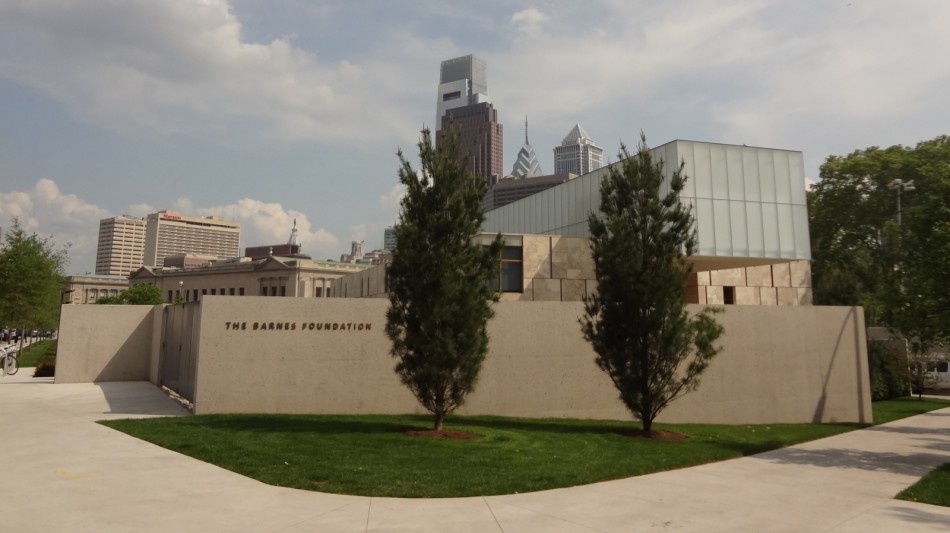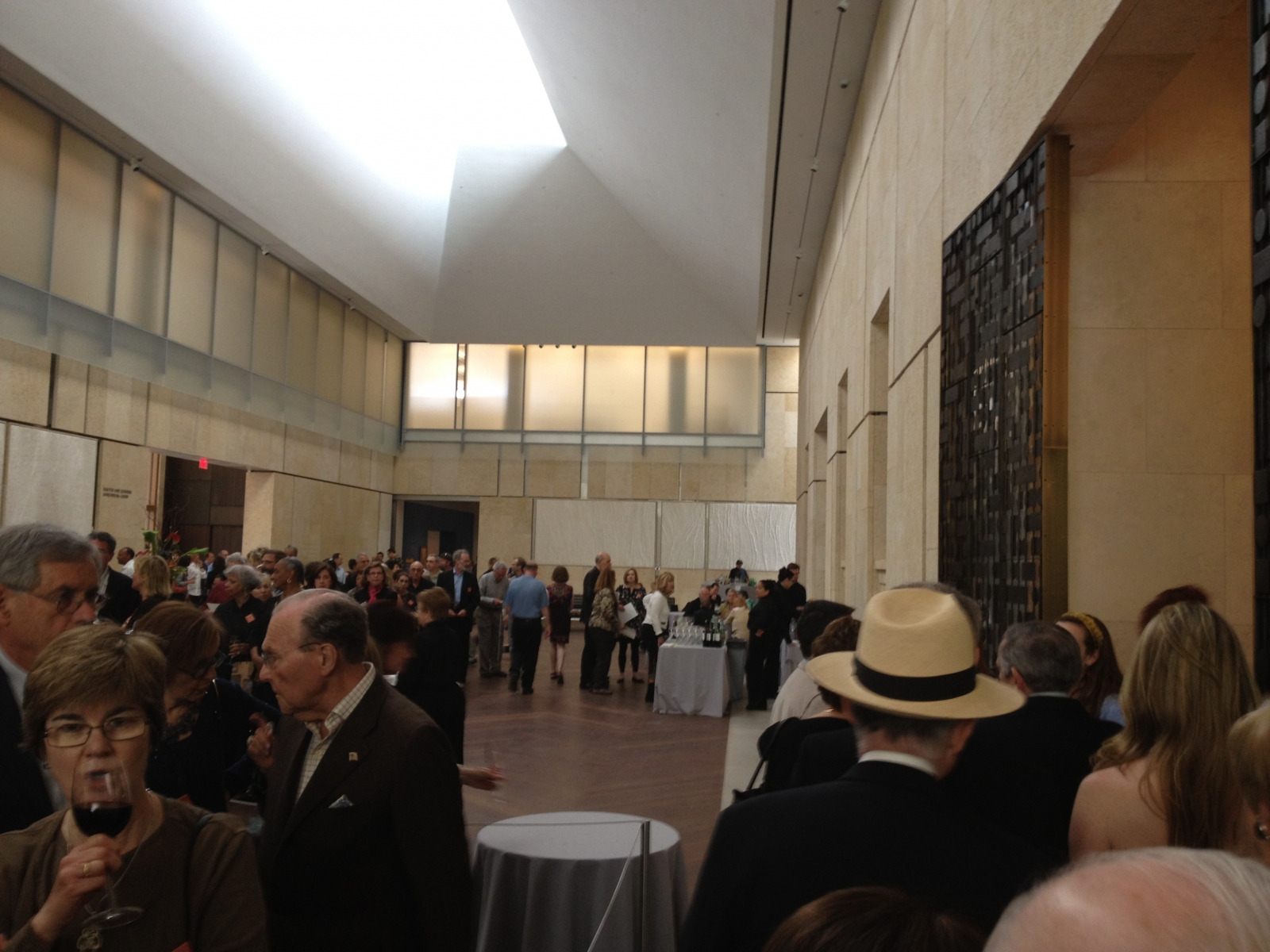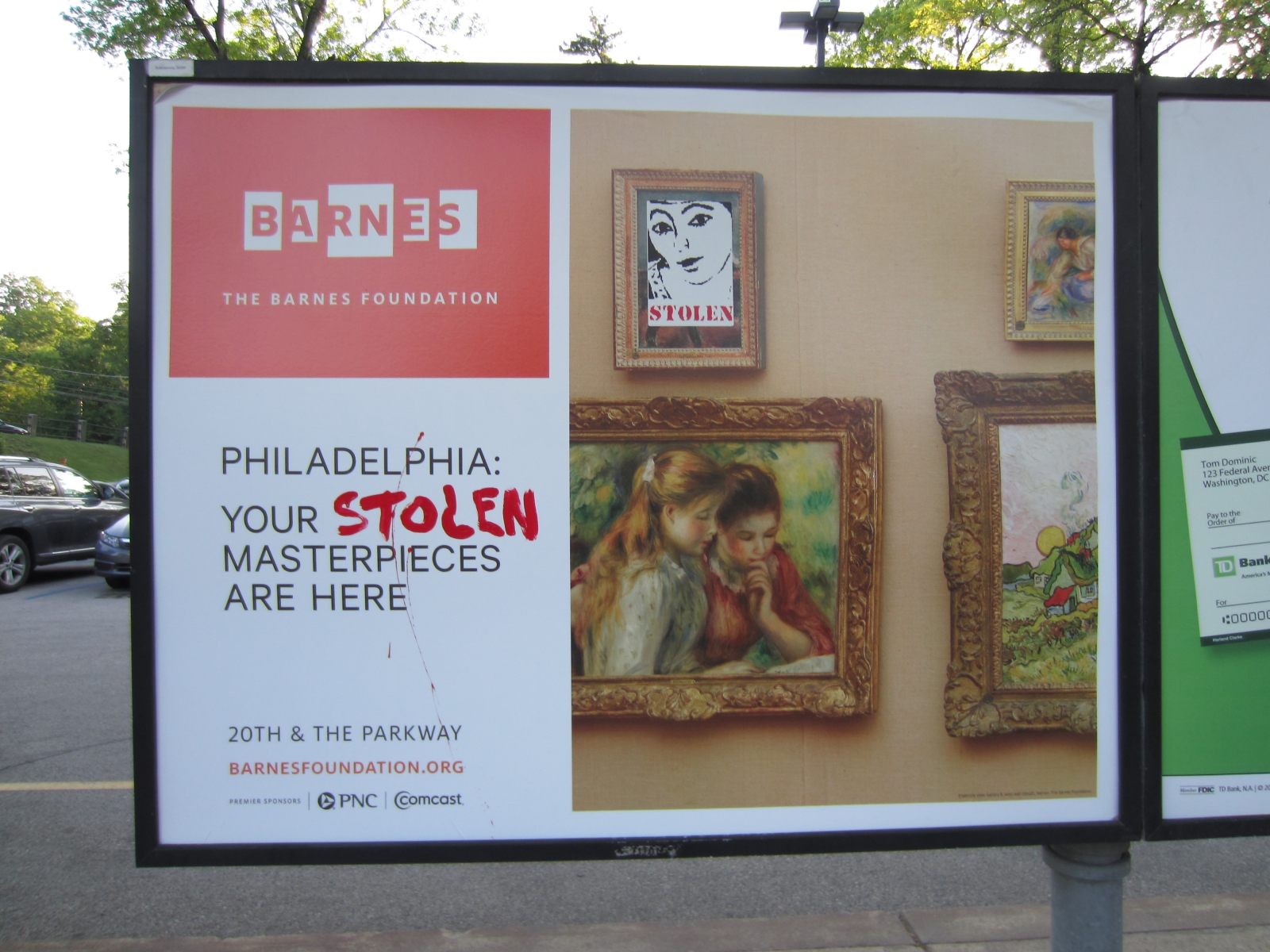
The Coveted Barnes Collection
The striking impression of the sleek modernist box on the Benjamin Franklin Parkway that now houses the Barnes Collection in a design by Tod Williams and Billie Tsien is that it’s not all that bad. C’est pas nul, as the French would say approvingly, and begrudgingly.
The new slab, on the grounds where a juvenile detention center once stood, has ingenious ways of bringing in light. So much light, in fact, that visitors may think the paintings were cleaned. The Barnes says that they were not. Insiders note that the curtains were usually drawn during the last years that the galleries of the old Barnes on Latches Lane in Merion, Pennsylvania were open, which gives the impressions that something has been done to the paintings today. You certainly see it on Renoir’s early Seated Torso – once grey, now luminous.

It's All in the Gesture -- Populism? But is this guide really doing what it looks like he's doing?
In the Williams/Tsien design, the interplay of indoor and outdoor spaces gives an expansive feel to already-open interiors that wrap the contained faux-Barnes reconstruction. Part of the mandate in bring the Barnes collection to this central location was that the paintings be shown as Barnes exhibited them. Is it a salute to the man who assembled the collection, or the tipping of one’s hat to the elderly gentleman who’s just been knocked down?
There would be a serenity to the place if it weren’t already being primed for indoctrination of schoolchildren, in the expectation that the exposure to art will be salutary (and that the site’s history as a juvenile detention center will be forgotten, along with the Barnes Foundation’s past in Merion Township. These links by Roberta Smith in The New York Times, and Linda Yablonsky in ArtNet, represent the prevailing journalistic mood of let the past be forgotten. Judith Dobryznski in Real Clear Artstook a longer view in a post of May 21st.)
A dissenter from the chorus of strokers opined at the Huffington Post with Notes from a Crime Scene. In the New Republic, Jed Perl made what now seems like an obvious point. Don’t weigh in on the atmosphere of a museum without seeing what the place is like when it is open to the public. It’s a bit like reviewing a restaurant for the public after the owner provides you with a special meal.)

Ellsworth Kelly's Stake through the Barnes's Heart
As the speeches by the new Barnes’s many proud godfathers at the press preview attested, the people who paid for what they call the new Barnes “campus” believe in education. There’s even a program for children ages 3 to 5 – the Pew Charitable Trusts, a funder and philanthropic arm-twister behind the Barnes move, is a supporter of pre-K education. Yet funders probably don’t remember that the collection was marketed to Toronto by Glenn Lowry (then director of the Art Gallery of Ontario, which paid $1 million to host the show, and another $1 million for the opening party; now director of MoMA) as “Our Bare Naked Ladies.” Which nudes will be shown to Philadelphia’s toddlers?
But worrying about peripheral things gets at the problem that still plagues the Barnes. Was it necessary? The building is said to have cost some $150 million, plus $50 million for endowment (which some say has been pledged, but not raised), plus a donation of land from the city of Philadelphia, plus state funding that went to Lincoln University. Lincoln was the entity assigned to name four out of five trustees (after those whom Barnes had named died), in exchange for Lincoln not filing a lawsuit against the decision to move the place. Add to all that the huge legal fees that made the move happen. So we have the tail waging the dog, an inflated superstructure which creates a cordon autoritaire around the art. Call it assisted living, or assisted embalming.
The art looks fine. In the main room, you can see The Models, the extraordinary picture by Georges Seurat of models for La Grande Jatte undressing at their leisure after posing in clothes which didn’t belong to them that they couldn’t afford. There’s also Henri Matisse’s Seated Riffian, Cezanne’s Bathers, and Renoir’s Caryatids — a set of two paintings from the work of Renoir’s much-maligned late period, which remind you why Picasso and Matisse collected them. The Joy of Life by Matisse is now the centerpiece of a small room upstairs, taken out of the stairwell where it was displayed in the old barnes. You can see a lot more of the place on the Philadelphia Inquirer’s slide show.
Not much attention is paid to the Old Masters, nor to the American paintings (although Lita Solis-Cohen of the Maine Antiques Digest reports that Richard Wattenmaker’s book on the American paintings at the Barnes is excellent.)
In a gallery devoted to temporary exhibitions, a biographical show about Barnes reveals some rarely seen photographs, but makes a self-serving point that Barnes changed the wall displays frequently — so it must be OK to spread the rooms out here. Still, the documentation, complete with the bed of Fidele, the dog who died in the fatal crash that killed Barnes in 1951, will fill some gaps.
Let’s just say that the new Barnes is more about the people paying for it (except for the taxpayer, that is) than it is about the man who did the collecting. There is a Walter Annenberg Court – without any art, however, since Annenberg, a proud Philadelphian, gave it all to the Metropolitan Museum in New York, with the stipulation that nothing be loaned or sold. For Barnes, Annenberg had different standards.

The New Barnes - Lots of Party Space in the Annenberg Court, But None of the TV Guide Owner's Art , Which Went to the Met
There is plenty of party space. Even so, trees planted by the landscape architect, Laurie Olin, had to be uprooted to make room for a huge tent to welcome the Philadelphia rich at the opening. Priorities, please.
Pomposity so dominates the new Barnes that you find yourself wishing that Philadelphia would find its inner Michael Moore. All isn’t lost. There’s a parody of Paul Goldberger’s glowing Vanity Fair assessment of the new Barnes – the original is being gilded before officials at the Barnes frame it. But this twist on Goldberger’s swoon is a lot more, with a clever post-modernism.

The Populist Barnes Hears the Voice of the People
There also seems to be a guerrilla campaign defacing the Barnes posters that are everywhere. Frank Rizzo or not, Philadelphia has never been good at policing itself.
Feature image: The Barnes Foundation, Philadelphia – Tod Williams / Bille Tsien, architects; Pew, Annenberg, and other foundations, undertakers.
Editor’s Note: David D’Arcy has covered the Barnes Foundation for The Art Newspaper and other publications since the controversy over its move to Benjamin Franklin Parkway first developed in the 1990s. He was interviewed by filmmaker Don Argott for Argott’s 2010 Art of the Steal, a documentary which Robert Zeller compared to Edward R. Murrow’s Harvest of Shame in speaking truth to power. (Link to Zeller’s review here.) We have widely linked in this review to alternative points-of-view on the new Barnes. Comments are welcome.
